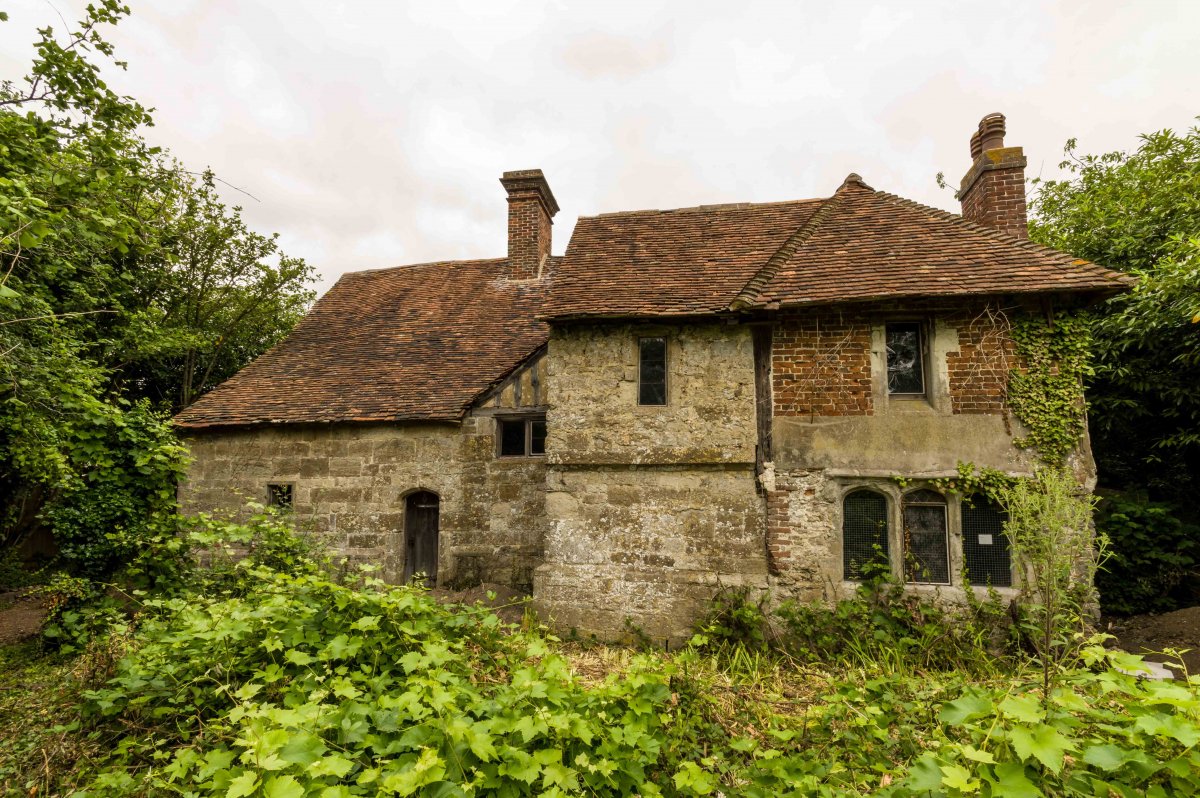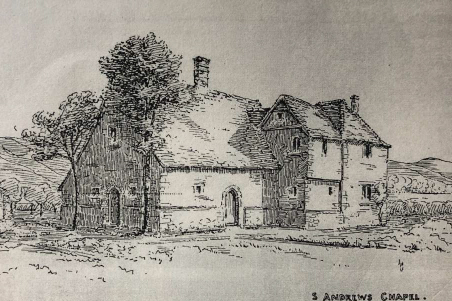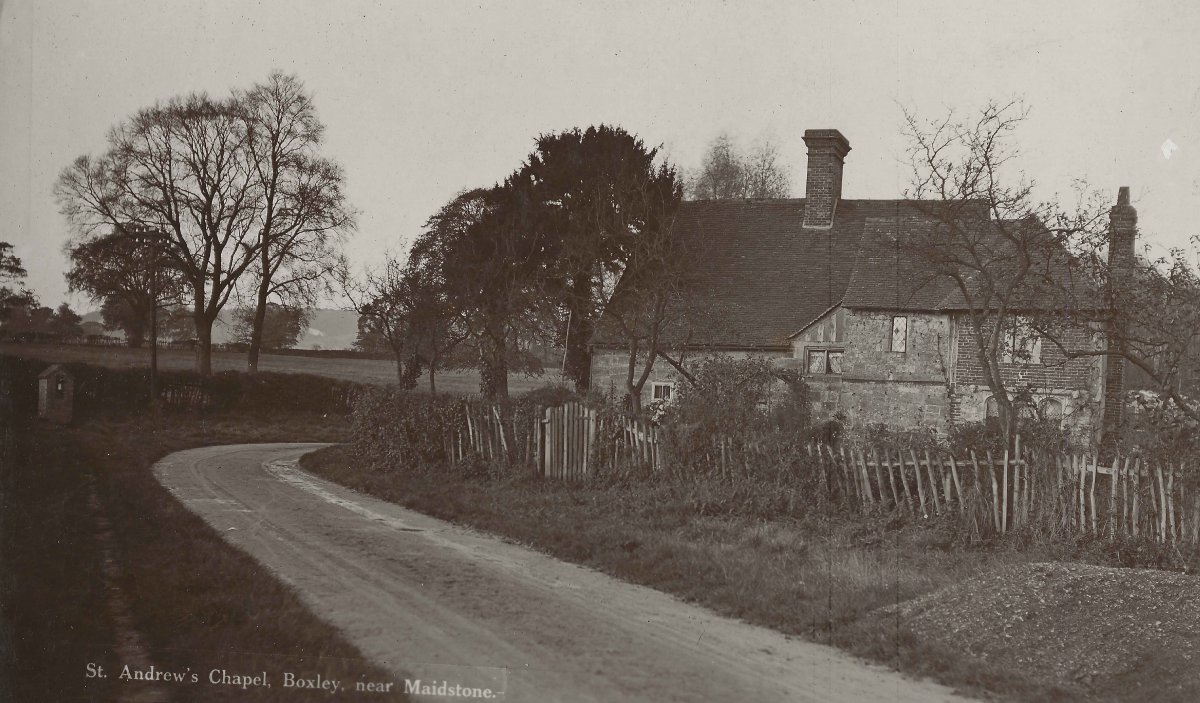A former chapel, a 20th century post office, a Victorian home, the site of a ginger-beer making business and the home of a relic – the finger of St Andrew. This gatehouse chapel, St Andrews in Sandling Kent, has had a long and winding history. What makes the building so intriguing is that most of its incarnations can be read in the fabric of the building. The medieval chapel has been added to and extended over the years, leaving the SPAB a puzzle to unpick as we repair this ‘sleeping beauty’ of a building, untouched since the 1960s.
A site of pilgrimage
We believe the chapel, the oldest part of the building, was constructed in 1484. A dendrochronological survey and fragments of late medieval pottery from a archaeological dig supports this. Unfortunately we don’t know anything about the founder – often chapels of the 15th and early 16th centuries that were endowed by wealthy families.
St Andrews sits less than a quarter of a mile west of Boxley Abbey, a Cistercian monastic site. The west entrance to Cistercian houses usually had two gatehouses – the inner and outer. Gatehouse chapels, like St Andrews served people living or staying outside the precinct boundary, and those who were not allowed within the main gate, such as women and the poor.

St Andrews, 2020. Credit: Daniel Bridge
These gatehouse chapels were sometimes designated for people on pilgrimage. Boxley Abbey stands on the route of Pilgrims Way to Canterbury (one of the most important sites of pilgrimage in England at the time). Although it’s believed Boxley Abbey and St Andrews could have been pilgrim destinations in their own right. St Andrews seems to have housed a relic, the finger of St Andrew clad in silver. The former chapel, our building, still has squints to the north and south that would have allowed glimpses of the relic from outside.
Uncertain times
In January 1537 the last Abbot of Boxley surrendered the Abbey and its surroundings to Henry VIII. The appropriated lands were distributed among his courtiers. In 1540 they were passed to one of Henry’s most loyal courtiers, Sir Thomas Wyatt of Allington Castle. Boxley Abbery and St Andrews was then regranted to his son, Sir Thomas Wyatt the Younger – poet and rumoured lover of Anne Boleyn. Wyatt’s lands were forfeited to the Crown in 1554 after the uprising against Queen Mary’s Spanish alliance.
Many Cistercian gatehouse chapels that have survived to the present day became Parish churches after the dissolution but St Andrews was converted to a dwelling in the late-16th or early 17th century. The Chapel was extended to the west, north and south. A floor and partitions were inserted, and a large central chimney stack was constructed allowing for two approximately equal rooms on each floor. The dating and sequencing of these works, however, is not certain. After that St Andrews falls into nearly 300 years of obscurity – we know very little about the building’s occupants during this time. The next time the chapel shows up in our research is in 1814, when it was purchased by the Earls of Aylesford for £16000

St Andrews Chapel sketch c1870. Publishedin Cave-Browne’s History of Boxley Parish,1892
Local history
The Rev. Frederick Jonathan Richards in his Notes about Boxley, 1870, wrote about St Andrews: ‘The Cottage is still in the occupation of a poor widow, whose family have lived in it, under the possessors of Boxley Abbey for more than a century… The Archer family had lived in St. Andrew’s from the end of the 18th century, leasing the Chapel, cottage, yard and adjoining pastureland which they farmed.
Entirely covered in foliage and showing signs of vandal damage when the SPAB purchased the building in winter 2018, in 1834 S.C. Lampreys described St Andrews: “remarkably picturesque old stone cottage …. the chapel and the curate’s apartments, which are attached to it, are still almost entire, and are well worth the notice of the antiquary.’ (In A Brief Historical and Descriptive Account of Maidstone and its environs)
On the death of his father in 1871, the 7th Earl of Aylesford inherited the Estate. He ran up large debts that he charged against his inheritance. In order to repay debts they sold almost all the family estates. Lord Romney bought the Kent estate for £100,000 at auction in 1884. Just 6 years later, in 1890, the Boxley Abbey Estate was again auctioned. St Andrews was described as follows: Old Chapel dedicated to St. Andrew the Apostle but now occupied as a Dwelling House.
More to come on the recent history of St Andrews.

St Andrews, c.1900
With special thanks to the Architectural Heritage Fund and The Pilgrim Trust.
